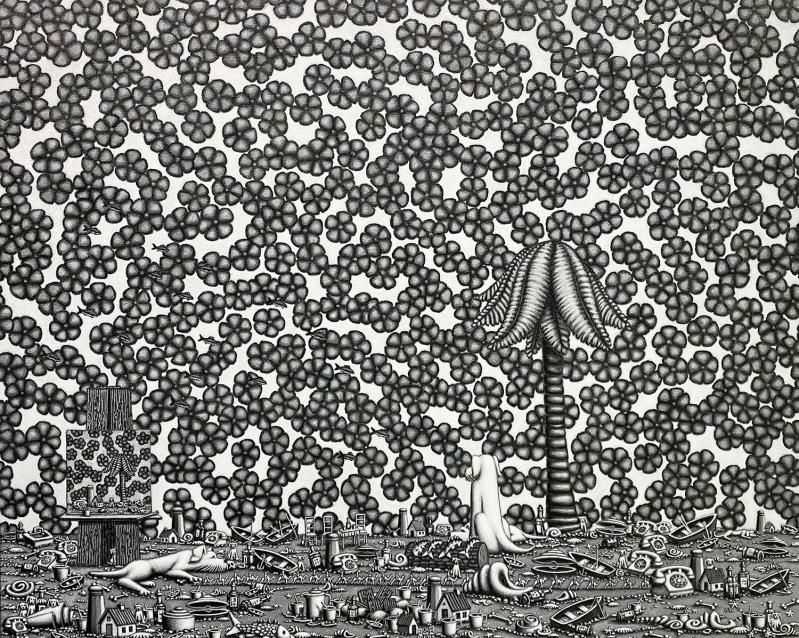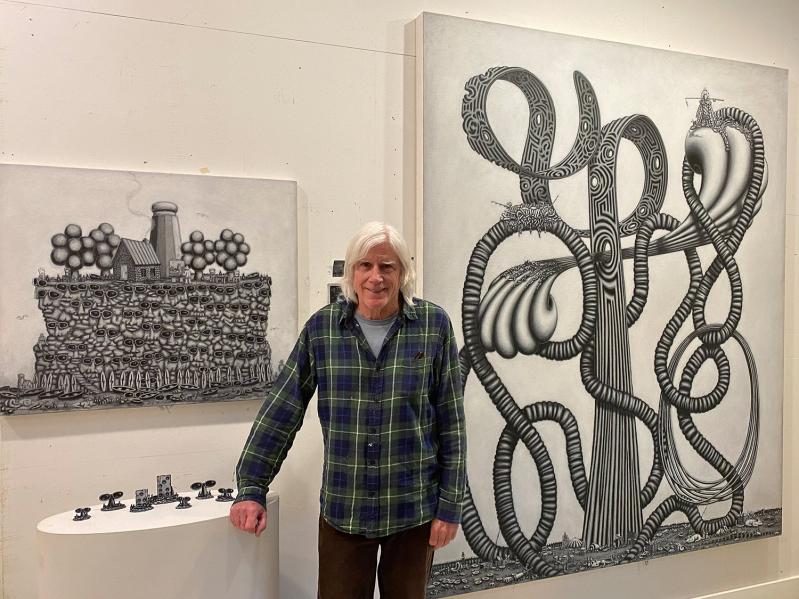Fifteen years ago, the artist Jamie dePasquale believed himself to be at a dead end. "I didn't know what I was going to do," he said during a recent tour of his Bridgehampton studio. "So I thought, I used to surf all the time, and on surf trips palm trees were always something I liked. So I did this painting of a palm tree."
That led to a series of monumental black-and-white paintings inspired by palm trees, lighthouses, even a Calder mobile, although those "muses," as he calls them, were only the starting points for works of remarkable complexity. What links them is that each has a dominant component that sits atop a horizon line or ground, which becomes the site of a profusion of images.
It began with the first palm tree, which sat alone on a beach. "It was kind of decorative," the artist said. Later, when his son, who was 9 at the time, brought home a bucket of crabs caught at Mecox Bay, "I picked up this crab, and all the segments of it were the perfect size. The scale was just what I was after. So I painted two crabs kind of worshipping this palm tree, and it made a creepy painting, it put an edge to it."
Embarked upon a second canvas, this time with two palm trees, he thought of putting more crabs on the bottom, but decided against it. "I've got to dream up a whole other thing going on on the ground," he said. "And that started what I'm doing lately -- creating this funny little narrative down on the ground with objects, parts of my life, things that keep recurring. I'm kind of developing this vocabulary."
Mr. dePasquale, who was born in East Williston, came came to Montauk with his family in the mid-1960s, first camping in Hither Hills, then renting at Ditch Plains, finally buying a house near the Montauk Community Church in 1969. Before 1971, when surfboard leashes were introduced, "I had to swim after my board to retrieve it. Especially out in Montauk with the cliffs and rocks, your board was just a mess."

Sure enough, the cliffs and lighthouses were always subjects he wanted to paint, and he started his first lighthouse in 2015. "It looked like a lighthouse scene on a cupcake," he said, laughing, so he began to transform the rocks on the cliff into faces. "Then I had this crazy idea to put glasses on all the ridges of the noses."
The beach below the painted cliff is lined with surfboards, boats, bottles, even a miniature lighthouse and a fisherman who emerges from the mist. The main lighthouse, which deliberately resembles a salt shaker, is connected to a stone house and surrounded by lawn furniture, an artist painting the scene at an easel, and stylized trees.
"I'm not relying on a brushstroke to animate the surface," Mr. dePasquale said. "They're surreal paintings, but they're very personal." He doesn't start with a vision of the whole; rather, each painting grows by accretion.
After a second lighthouse painting, he decided to return to the palm tree, in this case more modestly scaled in relation to the landscape. The ground of that painting is a perfect example of how he plays with scale.
A frieze of camels moves across the landscape, each one smaller than any of the other items, among them telephones, dogs, a couple of lighthouses, boats, fish -- each meticulously rendered but with total disregard for their relative scale. And, of course, there is an easel on the lower left holding a painting of the same scene.
Mr. dePasquale was recently in New Orleans, where he saw early northern European paintings at the art museum. "There was this piece with all these dead fish and shells on the beach. Those guys really knew what they were doing." It's no surprise to hear that one of his high school art teachers always said, "More detail, more detail."
After graduation, he took a semester off before enrolling part time at Southampton College, in 1972. In one of his classes the professor showed a movie about artists, one of whom was Roy Lichtenstein.
The following week, the professor asked Mr. dePasquale if he wanted to interview for a job with Lichtenstein, who was living in Southampton and looking for an assistant. "I started working for him, and it worked out nicely, because his son David was an avid surfer. We became really close friends. I started working with Roy in 1972, when I was 19. I'm still employed by the estate, and I just turned 70."
Mr. dePasquale dropped out of college but continued painting, and began to show his work to Lichtenstein. "I had him critique my work. He was a hard teacher," The teacher's young assistant became committed to art as a career.
In 1979, he entered a juried exhibition at the Parrish Art Museum. The juror, John Russell, who was a chief art critic at The New York Times, awarded first prize to his six-by-four-foot painting of a swan. A solo show at the Parrish followed a year later.
Mr. Russell also helped connect Mr. dePasquale with the Monique Knowlton Gallery in SoHo. At that time he was making stylized animal paintings "on the surreal side. Looking back, some of them were okay, a lot of them were really stupid."
In 1986, he exhibited the painting "Bull" in "Eleven Painters" at Guild Hall. The background resembled a Jackson Pollock; the animal was painted with Jasper Johns-like cross-hatching, and a cloud and the ground looked like a Warhol Coca-Cola silkscreen. The museum purchased the painting, and it was included in its 90th anniversary collection show in 2021.
Among the patterns in the paintings he exhibited at Guild Hall was one of a crossword puzzle. Mr. dePasquale showed it to Julian Schnabel, who suggested "a crossword puzzle painting all by itself would be cool." He made 12, and Mr. Schnabel showed one to the dealer Tony Shafrazi. A show of the monumental crossword paintings followed in 1987 at Mr. Shafrazi's gallery, and Mr. Schnabel bought one.
A second solo show of "Playing Card" paintings followed at Shafrazi a year later. Mr. dePasquale said his experience with the gallerist was a good one. "When I talked to Tony about paintings, he really made me think about things. 'You need more, it has to be more like a Hitchcock movie, there's got to be more little subtle stuff.' Roy was un-that."
After Mr. Shafrazi moved uptown and on to more blue-chip artists, Mr. dePasquale had a solo show at O.K. Harris Gallery in SoHo, and in 2015 he showed the "Palm Tree" paintings at Gallery Shchukin in Manhattan.
An exhibition of the "Palm Tree," "Lighthouse," and other black-and-white paintings, organized by the filmmaker Lana Jokel, will open at MM Fine Art in Southampton on June 17.




